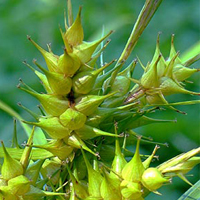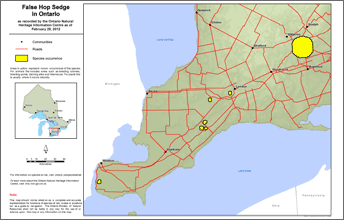False hop sedge
Scientific name: Carex lupuliformis

Cover photo credit: Allen Woodliffe
Status
Endangered
"Endangered" means the species lives in the wild in Ontario but is facing imminent extinction or extirpation.
Date added to the Species at Risk in Ontario List
The False hop sedge was already assessed as endangered when the Endangered Species Act took effect in 2008.
Read the Assessment Report
What it looks like
False Hop Sedge is a grass-like perennial plant that grows 50 to 130 centimetres tall, typically forming dense clumps of several stems. It has a triangular stem and four to seven leaves about 30 to 80 centimetres long.
Flowers grow in three to eight spikelets near the top of each stem, which are typically light green but become light brown as they age.
Where it lives
In Canada, this plant most often grows in riverine swamps and marshes, and around temporary forest ponds. It prefers open areas and areas under forest canopy openings, with lots of sunlight.
Where it’s been found in Ontario
False Hop Sedge ranges from Florida and Texas north to Quebec and Ontario. In Ontario, seven occurrences are known to persist.
In Quebec, there are three persisting populations and three populations that are being restored where False Hop Sedge is believed to have been extirpated.
The largest populations occur in southern Ontario.
View a larger version of this map (PDF)
What threatens it
The main threat to this plant is habitat loss and degradation, especially conditions that reduce the amount of sunlight reaching the plant.
Competition from invasive plants such as Reed Canary Grass (Phalaris arundinacea) and Tall Manna Grass (Glyceria maxima) is an increasing threat.
Changes to the quantity and quality of ground and surface water due to the operation of dams, development and agricultural activities may also threaten False Hop Sedge.
Action we are taking
Endangered Species and their general habitat are automatically protected
Recovery strategy
A recovery strategy advises the ministry on ways to ensure healthy numbers of the species return to Ontario.
Read the executive summary and full document (June 15, 2017)
Government response statement
A government response statement outlines the actions the government intends to take or support to help recover the species.
Read the government response statement (February 27, 2018)
Review of Progress
A review of progress made toward protecting and recovering a species is required no later than the time specified in the species’ government response statement, or not later than five years after the government response statement is published if no time is specified.
Read the report on progress towards the protection and recovery of 11 species at risk, including False Hop Sedge (2023).
Habitat protection
General Habitat Protection - June 30, 2008
What you can do
Report a sighting
- Report a sighting of an endangered animal or plant to the Natural Heritage Information Centre. Photographs with specific locations or mapping coordinates are always helpful.
Volunteer
- Volunteer with your local nature club or provincial park to participate in surveys or stewardship work focused on species at risk.
Be a good steward
- Private land owners have a very important role to play in species recovery. If you find False Hop Sedge on your land, you may be eligible for stewardship programs that support the protection and recovery of species at risk and their habitats.
- Invasive species seriously threaten many of Ontario’s species at risk. To learn what you can do to help reduce the threat of invasive species, visit:
www.ontario.ca/invasivespecies
www.invadingspecies.com
www.ontarioinvasiveplants.ca - The Canada-Ontario Farm Stewardship Program is available to farmers registered under the Canada-Ontario Environmental Farm Plan to encourage greater protection and conservation of habitat for species at risk.
Report illegal activity
- Report any illegal activity related to plants and wildlife to 1-877-TIPS-MNR (847-7667).
Quick facts
- The tiny flowers of False Hop Sedge are wind pollinated, so the plant does not attract many insects. However, the caterpillars of various butterflies, skippers, and moths feed on various sedge species, while a number of species of birds feed on the seeds.
- The plant’s spikelets are quite large and have been compared in appearance to spiked clubs and similar weapons used in medieval battles.
- As the name suggests, False Hop Sedge closely resembles Hop Sedge (Carex lupulina). The only reliable way to distinguish them is by closely examining the fruit, which has distinctive knobs on the two outer edges in False Hop Sedge.
- It is believed that this plant’s seeds are dispersed by water.
